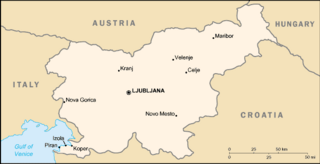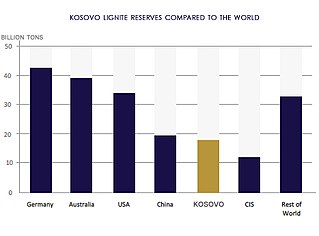Related Research Articles

The European Bank for Reconstruction and Development is an international financial institution founded in 1991. As a multilateral developmental investment bank, the EBRD uses investment as a tool to build market economies.

Vattenfall is a Swedish multinational power company owned by the Swedish state. Beyond Sweden, the company generates power in Denmark, Finland, Germany, the Netherlands, and the United Kingdom.

Šoštanj is a town in northern Slovenia. It is the seat of the Municipality of Šoštanj. The area is part of the traditional region of Styria. The entire municipality is now included in the Savinja Statistical Region.

The Electricity Generating Authority of Thailand (EGAT) is a state enterprise, managed by the Ministry of Energy, responsible for electric power generation and transmission as well as bulk electric energy sales in Thailand. EGAT, established on 1 May 1969, is the largest power producer in Thailand, owning and operating power plants at 45 sites across the country with a total installed capacity of 15,548 MW.

Energy in Bulgaria is among the most important sectors of the national economy and encompasses energy and electricity production, consumption and transportation in Bulgaria. The national energy policy is implemented by the National Assembly and the Government of Bulgaria, conducted by the Ministry of Energy and regulated by the Energy and Water Regulatory Commission. The completely state-owned company Bulgarian Energy Holding owns subsidiaries operating in different energy sectors, including electricity: Kozloduy Nuclear Power Plant, Maritsa Iztok 2 Thermal Power Plant, NEK EAD and Elektroenergien sistemen operator (ESO); natural gas: Bulgargaz and Bulgartransgaz; coal mining: Maritsa Iztok Mines. In Bulgaria, energy prices for households are state-controlled, while commercial electricity prices are determined by the market.

Kosovo is a developing country with an economy that functions on the principles of the free market, with a large private sector. Kosovo is an upper-middle income economy according to the World Bank, and is a member of the World Bank and the International Monetary Fund. Its official currency is the euro.

The Turceni Power Station is situated in Gorj County, on the banks of the Jiu River, halfway between the cities of Craiova and Târgu Jiu.

Energy in Germany is obtained for the vast majority from fossil sources, accounting for 77.6% of total energy consumption in 2023, followed by renewables at 19.6%, and 0.7% nuclear power. On 15 April 2023, the three remaining German nuclear reactors were taken offline, completing its nuclear phase-out plan. As of 2023, German primary energy consumption amounted to 10,791 Petajoule, making it the ninth largest global primary energy consumer. The total consumption has been steadily declining from its peak of 14,845 Petajoule in 2006. In 2023 Germany's gross electricity production reached 508.1 TWh, down from 569.2 TWh in 2022, and 631.4 TWh in 2013.
Boškov Most Hydro Power Plant, referred to as Boškov Most HPP, is a derivation plant planned to be built in Mala Reka valley, in the southernmost part of the Mavrovo National Park, in North Macedonia. It will have a total capacity of 71,5 MW. Construction is expected to last 4 years.

Energy in Greece is dominated by fossil gas and oil. Electricity generation is dominated by the one third state owned Public Power Corporation. In 2009 DEI supplied for 85.6% of all electric energy demand in Greece, while the number fell to 77.3% in 2010. Almost half (48%) of DEI's power output in 2010 was generated using lignite. 12% of Greece's electricity comes from hydroelectric power plants and another 20% from natural gas. Between 2009 and 2010, independent companies' energy production increased by 56%, from 2,709 Gigawatt hour in 2009 to 4,232 GWh in 2010.

Energy consumption per person in Turkey is similar to the world average, and over 85 per cent is from fossil fuels. From 1990 to 2017 annual primary energy supply tripled, but then remained constant to 2019. In 2019, Turkey's primary energy supply included around 30 per cent oil, 30 per cent coal, and 25 per cent gas. These fossil fuels contribute to Turkey's air pollution and its above average greenhouse gas emissions. Turkey mines its own lignite but imports three-quarters of its energy, including half the coal and almost all the oil and gas it requires, and its energy policy prioritises reducing imports.

Total primary energy supply (TPES) in Slovenia was 6.80 Mtoe in 2019. In the same year, electricity production was 16.1 TWh, consumption was 14.9 TWh.

RB Kolubara is a Serbian coal mining and smelting complex with headquarters in Lazarevac, Kolubara District. The mine has coal reserves amounting to 2.2 billion tonnes of lignite, one of the largest lignite reserves in Europe, and it produces 22.6 million tonnes of coal per year.

The electricity sector of Kosovo relies on coal-fired power plants and is considered one of the sectors with the greatest potential of development. The inherited issues after the war in Kosovo and the transition period have had an immense effect on the progress of this sector.

Kosovo has a slowly developing plain industry. In 2009, the Industry accounted for 22.60 of GDP and a general workforce of 800,000 employees. It's on 150 th place, compared to the rest of the world. There are numerous reasons for this kind of stagnation, ranging from consecutive occupations, political turmoil and the recent Kosovo War (1999).
Dariali Hydropower Plant, referred to as Dariali HPP, is a 108 MW run-of-the-river hydropower plant built in 2017 in Georgia. It is located on the Tergi River in Kazbegi Municipality, at less than 1 km from the Russian-Georgian border, 160 km far from Tbilisi.
There is enormous potential for renewable energy in Kazakhstan, particularly from wind and small hydropower plants. The Republic of Kazakhstan has the potential to generate 10 times as much power as it currently needs from wind energy alone. But renewable energy accounts for just 0.6 percent of all power installations. Of that, 95 percent comes from small hydropower projects. The main barriers to investment in renewable energy are relatively high financing costs and an absence of uniform feed-in tariffs for electricity from renewable sources. The amount and duration of renewable energy feed-in tariffs are separately evaluated for each project, based on feasibility studies and project-specific generation costs. Power from wind, solar, biomass and water up to 35 MW, plus geothermal sources, are eligible for the tariff and transmission companies are required to purchase the energy of renewable energy producers. An amendment that introduces and clarifies technology-specific tariffs is now being prepared. It is expected to be adopted by Parliament by the end of 2014. In addition, the World Bank's Ease of Doing Business indicator shows the country to be relatively investor-friendly, ranking it in 10th position for investor protection.
CEE Bankwatch Network is a global network which operates in central and eastern Europe. There are 17 member groups, multiple non-governmental organizations based in different locations; the network is one of the largest networks of environmental NGOs in central and eastern Europe. Bankwatch's headquarters rest in Prague, Czech Republic.

Lignite coal in Kosovo is and will continue to be an important local energy source due to its high reserves. Kosovo is very rich in lignite and accounts around 90% of Kosovo's electricity production. The nation has the 5th largest lignite reserves in the world and the 3rd in Europe. The lignite is distributed across the Kosovo, Dukagjin and Drenica Basins, although mining has so far been restricted to the Kosovo Basin. The lignite is of high quality for the generation of electricity and compares well with the lignite resources of neighbouring countries on a range of parameters. Kosovo's lignite varies in net calorific value from 6.28-9.21 MJ/kg, averaging 7.8 MJ/kg. The deposits can be up to 100 m thick, but average 40 m, and possess an average strip ratio of 1.7:1.
References
- 1 2 3 Rastello, Sandrine. Coal-Fired Plant in Kosovo Tests World Bank Clean-Air Pledge. Bloomberg, June 2, 2014. Retrieved on 2014-16-06.
- ↑ Kosova e Re lignite power plant, Kosovo. CEE Bankwatch. Retrieved on 2014-16-06.
- ↑ "Kosova e Re Introduction". Ministria e Zhvillimit Ekonomik. (Ministry of Economic Development). Retrieved 7 June 2018.
- ↑ Pippa Gallop (17 March 2020). "ContourGlobal finally quits Kosova e Re coal plant". Bankwatch Network. Retrieved 24 May 2020.
- 1 2 Government decides to build the new Kosovo power plant. New Kosova report, July 16, 2009. Retrieved on 2014-16-06. Archived July 14, 2014, at the Wayback Machine
- ↑ "Kosova e Re lignite power plant, Kosovo. KOSID. Retrieved on 2014-16-06". Archived from the original on 2017-12-23. Retrieved 2014-06-16.
- ↑ Friedman, Lisa. U.S. on Both Sides of New Battle Over Assistance to 'Ugly' Coal-Fired Power Plant. The New York Times, January 15, 2013. Retrieved on 2014-16-06.
- ↑ Prime Minister Thaçi received in a meeting senior representatives of the European Bank for Reconstruction and Development (EBRD). The office of the Prime minister of the Republic of Kosovo, June 17, 2014. Retrieved on 2014-16-06.
- ↑ Smith, Tierney. European development bank turns its back on dirty coal. The Global Call for Climate Action, December 10, 2013. Retrieved on 2014-16-06. Archived July 14, 2014, at the Wayback Machine
- 1 2 Expert Panel Finalizes its Review of the Kosovo Power Project. The World Bank, February 1, 2012. Retrieved on 2014-16-06.
- ↑ Salem, Harriet. Kosovo pays a heavy toll for lack of reliable energy. The Guardian, November 19, 2013. Retrieved on 2014-16-06.
- ↑ European Parliament resolution of 6 June 2013 on the European integration process of Kosovo. Retrieved on 2014-16-06.
- ↑ European Parliament wants green energy, not coal, as part of Kosovo integration. CEE Bankwatch, April 19, 2013. Retrieved on 2014-16-06.
- ↑ An Independent Study Challenges Energy Policy in Kosovo. The Institute for Development Policy. Published 02/02/2012. Retrieved 13/07/2014.
- ↑ "Kosova e Re lignite power plant, Kosovo Kosovo Civil Society Consortium for Sustainable Development. Retrieved 13/07/2014". Archived from the original on 2017-12-23. Retrieved 2014-06-16.